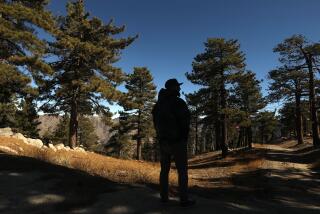Conservancy May Become Guardian of Chatsworth Preserve
- Share via
Bordered by tract housing and commercial strips, the Chatsworth Reservoir at the base of the Santa Susana Mountains is a hidden nature preserve, stocked with Chumash Indian ruins and a menagerie of wildlife.
But this 1,300-acre wildlife haven is enjoyed by only a select few who have the contacts to get past the surrounding chain-link fence.
That may change soon.
The Department of Water and Power, which owns the reservoir, is considering allowing the Santa Monica Mountains Conservancy to take over guardianship of the reservoir and provide regular public tours and hikes.
“It’s important that you provide access to people so they can enjoy it,” said Francine Oschin, assistant chief deputy to City Councilman Hal Bernson, who represents the Chatsworth area and who helped promote the discussions between the agencies. “We don’t want it so controlled that no one can enjoy it.”
The discussions between the two agencies focus on who will be responsible for paying the $250,000-a-year price tag for maintaining the reservoir. The costs would cover clearing the shrubs along the border of the reservoir to maintain a firebreak for nearby homes and rebuilding dirt roads through the area after rainstorms. A small pond in the reservoir also must be filled with water during dry months.
*
Bernson said the DWP also wants to see if it can get a pollution credit from the South Coast Air Quality Management District for turning the land over to the conservancy.
Debra Sass, a spokeswoman for the the department, said it may lease the property to the conservancy for a nominal annual fee if the two agencies can work out an agreement on the maintenance of the land.
The negotiations are expected to continue in earnest after conservancy officials tour the reservoir today.
If a deal can be reached, the public will have greater access to a facility that is home to nearly 150 species of birds, as well as coyotes, foxes, opossums and skunks.
The DWP provides access to the property only to those with special permission. Among the few groups allowed past the fence is the Audubon Society, which enters about six times a year to conduct bird counts, among other activities.
“It’s a very unique place in there,” said Karen Johnson, president of the San Fernando Valley chapter of the Audubon Society.
Built in 1919, the reservoir has been empty since 1969, when it was drained for enlarging. But it has not been used since then because after the 1971 Sylmar earthquake, it was determined that the reservoir’s dam was unsafe and that it was located over a seismic fault.
*
Today, the reservoir is a winter migration stop for Canada geese. Oschin said it also contains the remains of a Chumash Indian site, including a kiln that was used to fire bricks for the San Fernando Mission.
For years, city officials and others have discussed using the reservoir as a site for money-making endeavors, such as a golf course or a condominium complex.
But Bernson, an 18-year council veteran, has fought all development proposals, insisting that the reservoir remain a sanctuary for birds, fish and small mammals.
The city zoning on the land prohibits construction on the site. To make clear that residential and commercial development is prohibited, Bernson persuaded the council earlier this year to change the name of the reservoir to the Chatsworth Natural Preserve/Reservoir.
Bernson has said that he would only permit “passive uses” of the reservoir, meaning that hikes and tours would be permitted but picnics and mountain biking, for example, would not be allowed.
Johnson said the Audubon Society supports Bernson’s restrictions, adding that the reservoir’s wildlife should be protected from any disturbances.
More to Read
Sign up for Essential California
The most important California stories and recommendations in your inbox every morning.
You may occasionally receive promotional content from the Los Angeles Times.











